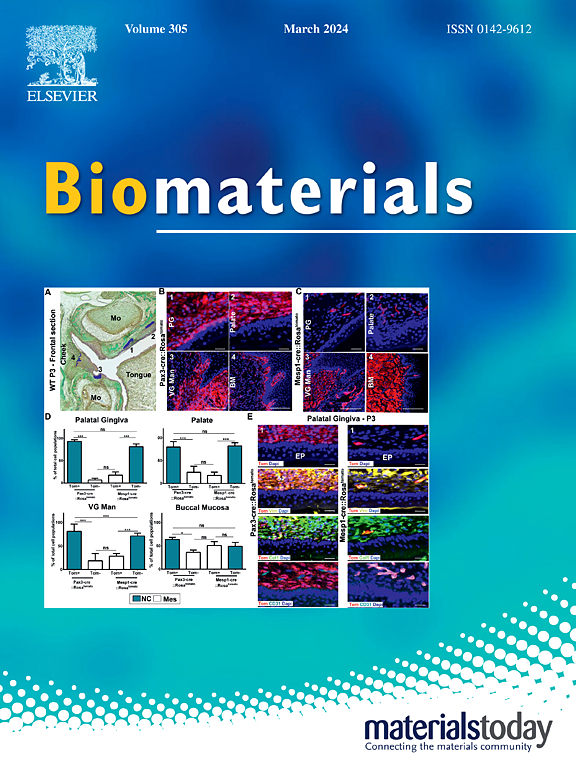可调节的生物力学壁龛调节间充质干细胞的肝分化用于急性肝衰竭治疗
IF 12.8
1区 医学
Q1 ENGINEERING, BIOMEDICAL
引用次数: 0
摘要
急性肝衰竭(Acute liver failure, ALF)是一种以肝细胞坏死和肝功能障碍为特征的危重疾病。目前,由于供体短缺,肝脏和肝细胞移植等有效治疗受到阻碍。因此,来源于人脂肪源性间充质干细胞(hADSCs)的肝细胞样细胞(HLCs)作为替代细胞具有巨大的治疗潜力。建立支持生态位有利于调节hscs向具有必要代谢和治疗功能的HLCs的分化。在这项研究中,我们开发了一种基于水凝胶的合成生态位,该生态位由脱细胞胞外基质(dECM)和氧化葡聚糖(ODex)组成。这些水凝胶具有可调的粘弹性和刚度,通过yes相关蛋白(YAP)机械转导调节肝脏分化。具体而言,更快的应力松弛速率和更低的硬度(接近小鼠肝脏)的组合促进了hascs的肝脏分化。此外,这个生态位还促进HLC在促血管生成、抗氧化应激和抗炎症方面的旁分泌功能。体内实验表明,基于水凝胶的生物力学小生境调节的HLCs对ccl4诱导的ALF小鼠具有满意的治疗效果。总的来说,这种基于水凝胶的干细胞生态位,模仿了天然肝脏的特征,具有优化的分化效率和治疗潜力,为利用生物材料进行肝组织工程提供了一种很有前途的方法。本文章由计算机程序翻译,如有差异,请以英文原文为准。
Tunable biomechanical niches regulate hepatic differentiation of mesenchymal stem cells for acute liver failure therapy
Acute liver failure (ALF) is a critical disease characterized by hepatocyte necrosis and liver dysfunction. Currently, effective treatments such as liver and hepatocyte transplantation are hindered by donor shortages. Consequently, hepatocyte-like cells (HLCs) derived from human adipose-derived mesenchymal stem cells (hADSCs) present substantial therapeutic potential as alternative cells. Establishing a supportive niche is conducive to regulating the differentiation of hADSCs into HLCs with the necessary metabolic and therapeutic functions. In this study, we develop a hydrogel-based synthetic niche composed of decellularized extracellular matrix (dECM) and oxidized dextran (ODex). These hydrogels, with tunable viscoelasticity and stiffness, regulate hepatic differentiation through Yes-associated protein (YAP) mechanotransduction. Specifically, a combination of faster stress relaxation rate and lower stiffness approximating that of mouse liver fosters the hepatic differentiation of hADSCs. Additionally, this niche also promotes HLC paracrine functions in pro-angiogenesis, anti-oxidative stress, and anti-inflammation. In vivo experiments reveal that hydrogel-based biomechanical niches-regulated HLCs demonstrate satisfactory therapeutic effects in mice with CCl4-induced ALF. Overall, this hydrogel-based stem cell niche, which mimics the characteristics of the native liver, with optimized differentiation efficiency and therapeutic potential, offers a promising approach for leveraging biomaterials in liver tissue engineering.
求助全文
通过发布文献求助,成功后即可免费获取论文全文。
去求助
来源期刊

Biomaterials
工程技术-材料科学:生物材料
CiteScore
26.00
自引率
2.90%
发文量
565
审稿时长
46 days
期刊介绍:
Biomaterials is an international journal covering the science and clinical application of biomaterials. A biomaterial is now defined as a substance that has been engineered to take a form which, alone or as part of a complex system, is used to direct, by control of interactions with components of living systems, the course of any therapeutic or diagnostic procedure. It is the aim of the journal to provide a peer-reviewed forum for the publication of original papers and authoritative review and opinion papers dealing with the most important issues facing the use of biomaterials in clinical practice. The scope of the journal covers the wide range of physical, biological and chemical sciences that underpin the design of biomaterials and the clinical disciplines in which they are used. These sciences include polymer synthesis and characterization, drug and gene vector design, the biology of the host response, immunology and toxicology and self assembly at the nanoscale. Clinical applications include the therapies of medical technology and regenerative medicine in all clinical disciplines, and diagnostic systems that reply on innovative contrast and sensing agents. The journal is relevant to areas such as cancer diagnosis and therapy, implantable devices, drug delivery systems, gene vectors, bionanotechnology and tissue engineering.
 求助内容:
求助内容: 应助结果提醒方式:
应助结果提醒方式:


